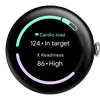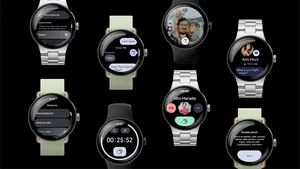How we built 3 key fitness metrics for Pixel Watch 3

The new Pixel Watch 3’s display is twice as bright as the last generation’s, and it comes in a new, additional 45mm size. It has smaller bezels and new color options. But as fresh as its exterior is, what’s going on underneath the hood of the Pixel Watch 3 is just as exciting — including improvements to how it uses Fitbit metrics to tell you about your health and fitness.
Our methodology and approach to building these metrics is based in sports medicine, and we’re continuously learning more and bringing that to Fitbit. Pixel Watch 3 features an all-new Daily Readiness algorithm to help you understand how your body is recovering from everyday life activity, as well as two new tools: Cardio Load and Target Load.
The team that built these new metrics brought deep expertise in fitness and medicine to their work. Cathy Speed is a professor of Sports Medicine and Human Performance at Cardiff Met University, as well as a senior clinical specialist on the Fitbit team. She also has a background in elite and high-performance sports medicine. “We have every single tool in the bag for elite athletes,” she says of her past work. “We monitor them, they’re experts in their own bodies and we are able to answer the question, “What should I be doing to train the smartest way I can today?’” With these Fitbit updates, Cathy and her team aimed to make this kind of information available not just to elite athletes, but to everyone. Here's a look at what went into improving Fitbit’s readiness and recovery tracking — and what led the team to introducing the two new scores.
Fine-tuning Daily Readiness
Fitbit launched the Daily Readiness Score in 2021 as a way to learn how well your body is recovering. “With the first version of Daily Readiness, the score incorporated a focus on activity as well as heart and sleep data,” Cathy says. This informed the app to tell you how ready (or not) you were for a workout.
For the launch of the Pixel Watch 3, the Fitbit team wanted to fine-tune the algorithm to tailor it even more to the key signs of your body’s recovery. To do so, they started with Pixel Watch 3’s multipath heart rate sensors. “These give us a good look at your heart rate, which is key to getting an understanding of your Heart Rate Variability, or the variability of timing between heartbeats,” Cathy says. “HRV is a very sensitive marker of physiological recovery; it tells us a lot. It’s almost like a very quiet warning sign that your body is starting to either struggle to recover or recovering well before you’re necessarily even fully aware of it.”
Daily Readiness looks at HRV as well as sleep and also added a new metric to its algorithm with resting heart rate — which is known to reflect longer-term impact, for example from illness. The result is a more comprehensive picture of your body’s recovery. But the team still felt they could help people better understand their training and know how much to take on, which is why they added Cardio Load and Target Load.
Introducing Cardio Load and Target Load
Cardio Load (which you'll find in the Fitbit app alongside Daily Readiness) helps you understand how hard your heart is working during activity as well as throughout the day. Based on your activity history, it even tells you your training status: if you are maintaining or improving fitness, or undertraining or overtraining. Then there’s Target Load, which gives you a recommendation about how much activity to take on today, tailored to your recent Cardio Load and training status as well as your Readiness. "We could have just added these data points to the Daily Readiness algorithm, and thus the Daily Readiness score, but that would have been making it something of a black box — instead you get a comprehensive picture of your body's recovery, as well as a practical goal of how much to take on as a result," Cathy explains.

“We think it’s more impactful to give people these personalized insights,” Cathy says. Just like with Daily Readiness, when you use Cardio Load and Target Load, the Fitbit app offers thorough explanations of what information the two features use to come up with their results: You can look at the breakdown of your daily Cardio Load (including by workout), see trends of your progress and get feedback based on your goals. And both Cardio and Target Load take into account periods of increased activity — for instance, if you’re training for a marathon or on a long backpacking trip. Cardio Load and Target Load will adjust to your activity levels over time, too.
Cathy says that making valuable, personalized information readily and easily available to everyone in this way almost feels “magic,” but it’s been a formidable process to get to this point. “If you told me 20 years ago that we would be doing what we’re doing now — that we’re essentially helping make people their own experts on their fitness — that would have been hard to believe!” And she knows it’s only going to get better from here. “That’s the great thing about this work: We helped develop this new product that’s out in the world now and we’re already thinking, ‘What might we do next?’”






